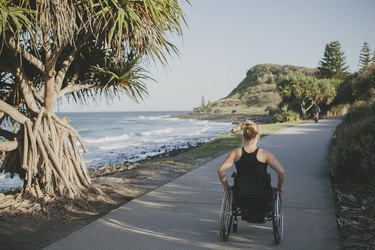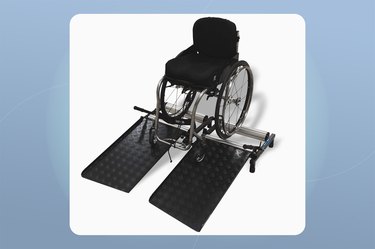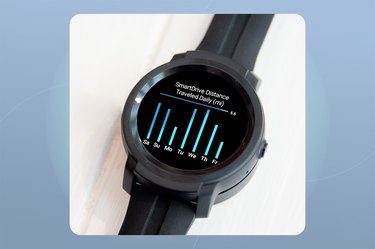
We may not all be Paralympians, but many wheelchair users like me can still benefit from a cardio workout.
The U.S. government's Physical Activity Guidelines for Americans recommend that all adults, with or without disabilities, get at least 150 minutes total (that's 2 1/2 hours) of aerobic physical activity per week, plus at least two weekly strength-training sessions.
Video of the Day
Video of the Day
But there's no straightforward consensus on what that physical activity looks like. While people who walk might aim for taking 10,000 steps a day, no such standard exists for people who use wheelchairs.
Experts say that's because government recommendations don't often consider disabled people. [Editor's note: LIVESTRONG.com typically uses person-first language such as "people with disabilities," but we recognize different people prefer different terminology. At the request of the writer, we are using identity-first language here.]
The current recommendations don't take into account several types of obstacles for disabled people, says Maureen Conner, PT, DPT, a physical therapist and neurologic clinical specialist at the Spinal Cord Injury Rehabilitation Program at Craig Hospital in Englewood, Colorado, including:
- Physical limitations, like decreased mobility or overuse injuries
- Environmental limitations, like difficulty accessing adaptive exercise equipment
- Psychosocial limitations, like limited caregiver availability or financial resources
In fact, there are very few published exercise guidelines for disabled people. One of them, an October 2017 review in Spinal Cord, suggests at least 20 minutes of moderate to vigorous aerobic exercise twice a week, as well as regular strength training. (That was specifically for people with spinal cord injuries, so it's worth noting these recommendations may not apply to people with other disabilities.)
But "moderate to vigorous aerobic exercise" is often determined by measuring things like heart rate. For a moderate cardio workout, your target heart rate would be between 64 and 76 percent of your maximum heart rate, according to the Centers for Disease Control and Prevention. For vigorous activity, you'd aim for a target heart rate between 77 and 93 percent of your MHR, an estimate of the fastest rate at which your heart can safely beat each minute during exercise that's based on your age.
Heart rate can be a great indicator of fitness for some people who use wheelchairs, but it may not be appropriate for everyone who does. Some wheelchair users have underlying conditions that "can result in cardiovascular dysfunction and blunted or abnormal responses to exercise, making monitoring exercise intensity through heart rate measurements difficult," Conner says.
Instead, she recommends wheelchair users monitor exercise intensity using what's called the rate of perceived exertion scale, or RPE. As the name suggests, RPE involves rating how hard you feel you're working.
There are many ways to rate your effort, but a straightforward version is to think of a scale from 1 (very light activity) to 10 (maximum effort). Anywhere from 4 to 6 is considered moderate intensity, while a 7 to 8 is vigorous, Conner says. "Because this scale is a bit more subjective, it can take a little practice to get comfortable using it."
Tip
Everyone — with or without disabilities — is different. Always check with your doctor before beginning any exercise program. People with certain conditions, such as myalgic encephalomyelitis/chronic fatigue syndrome (ME/CFS), may not be able to exercise at all.
Your doctor or a physical therapist can help you figure out activities that work for your body. You might also get ideas from members of online forums and support groups who share your condition(s).
Why Wheelchair Fitness Tracking Is Limited
Objective data — like speed and distance traveled — can be more difficult to track. Whereas ambulatory athletes can wear running watches or other fitness trackers, there are limited choices on the market for wheelchair users.
Conventional fitness trackers use arm movements to calculate steps. But wheelchair tracking involves more variables. Wheelchair users vary push styles depending on terrain and speed, for example. The type of chair matters, too: A very heavy "hospital" chair requires a lot more exertion to go the same distance in my titanium, aerodynamic TiLite.
A tracker made for wheelchair users would allow you to input the type of chair you use. Ideally, such a tracker would include a wheel sensor to take terrain and speed into account. But more data can overwhelm existing device algorithms and quickly drain batteries.
These types of adaptations to existing fitness trackers require time and effort, says Dan Ding, PhD, who runs the Human Engineering Research Laboratories at the Department of Rehabilitation Science and Technology at the University of Pittsburgh. And consumer fitness companies don't have much of a financial incentive to improve measurements for wheelchair users due to the relatively small size of the wheeling population compared to other customers in their base.
Dan's lab builds wheelchair activity tracker algorithms and equipment for research, but she says that companies aren't really interested in partnering with her lab or utilizing her research in their products. "As researchers, we don't really have a way to bring it to market. We don't really have a way to compete with these companies."
3 Companies Making a Difference
Here are a few of the brands that have made the effort to design and bring to market products that accurately track wheelchair activity. Each type works a bit differently and offers varying features.
1. Apple
- Product: Apple Watch
- Tracks: Outdoor wheelchair walk pace and outdoor wheelchair run pace
- Cost: From $399
Apple conducted extensive testing when designing its wheelchair tracking functions back in 2016, according to original reporting by Computerworld. The company says they're continually improving.
Apple Watch users can turn on the Wheelchair setting in the Health section of the Apple Watch app to track pushes instead of steps. Your iPhone will then register "different types of pushes, speeds and terrains," according to Apple.
Instead of a standing goal, you'll see a rolling goal, and two different exercise tracking options: outdoor wheelchair walk pace and outdoor wheelchair run pace, which correlate with leisurely wheeling or a more heart-pumping workout.
2. Invictus
- Product: Invictus Active Trainer Smart Plus + Wahoo Blue SC Speed and Cadence Sensor
- Tracks: Rolling speed, distance, calories and heart rate
- Cost: £799 plus shipping to the U.S. from the U.K
As I continue to mostly shelter at home because I'm at high risk for COVID-19 complications, I decided to buy an Invictus Active wheelchair treadmill so that I could keep my activity and fitness levels high while working out at home.
Invictus offers a "Smart Plus" model of their wheelchair treadmill that uses Wahoo's Blue SC tracker, which allows me to track my speed and distance traveled. (It also includes a Tikr Fit armband to measure heart rate.)
Rather than measuring wheel pushes like other trackers, this setup instead tracks the number of times the treadmill's roller rotates and then calculates the distance traveled. Because the device relies on roller size and not wheel size, which can vary, it eliminates a data variable and provides more accurate distance measurements.
"If you owned a scale and you didn't have confidence in the scale being correct, you wouldn't use it," Invictus owner and wheelchair user Scott Smith tells LIVESTRONG.com. "This is a similar thing. Without accurate data, people won't use it."
3. Permobil
- Product: PushTracker and PushTracker E2
- Tracks: Wheelchair pushes and travel speed
- Cost: $200 to $225
Permobil makes TiLite manual wheelchairs and the SmartDrive power assist, a lightweight motor for manual wheelchairs. I own a TiLite and frequently use my SmartDrive when I'm going to be out for a while; it helps with fatigue and stress on the shoulders by reducing the amount you have to push.
You can control the SmartDrive with a wrist wearable called the PushTracker (otherwise you have to push the wheel of the chair to start the motor). The wearable syncs with the PushTracker app, which tracks wheelchair pushes, distance traveled daily and coast time (or the time between pushes), says Curtis Merring, an occupational therapist and Permobil's director of portfolio marketing.
The newer smartwatch model, PushTracker E2, provides more accurate data and can send you personal record notifications. It can also schedule handy wheelchair maintenance reminders. Together with the app and SmartDrive, it serves the dual purpose of tracking activity and providing battery assistance to decrease the demand on your upper body.
Where Do We Go From Here?
Apple and Permobil say they are continually improving their technology and upgrading their wearables. Invictus is working on creating Peloton-style virtual workout classes. I'm looking forward to joining them.
The ability to work out at home gives disabled people independence and privacy. We don't have to rely on a gym that might not provide us with the equipment or support we need. We don't have to worry about being accepted by the fitness community there.
Plus many of us wheelchair users can't go to the gym; we might be homebound or at too high of a medical risk, for example. Being able to join streaming classes provides immediate feedback and companionship. But it remains to be seen when we will have access to the same benefits of tracking our activity that ambulatory exercisers do.
Until then, there are a few things exercisers of all abilities can do to help advance accessibility in fitness tracking:
- Ask questions. Talk to people who work at your local fitness facilities and ask them what kinds of changes they plan to make to accommodate a diverse range of athletes and when you can expect those changes.
- Contact brands. The more brands hear from customers asking about accessibility features, the more of a priority they'll realize those features need to be.
- Support the brands making change. As the saying goes, vote with your dollars. Purchase products with accessibility features, even if you won't use them, rather than products that aren't as inclusive.
Related Reading
- Department of Health and Human Services: "Physical Activity Guidelines for Americans"
- Centers for Disease Control and Prevention: "Physical Activity for People with Disability"
- Spinal Cord: "Evidence-based scientific exercise guidelines for adults with spinal cord injury: an update and a new guideline"
- Computerworld: "The story behind Apple's wheelchair Activity app"
- CDC: "Target Heart Rate and Estimated Maximum Heart Rate"
- Apple: "Use Accessibility features on your Apple Watch"


